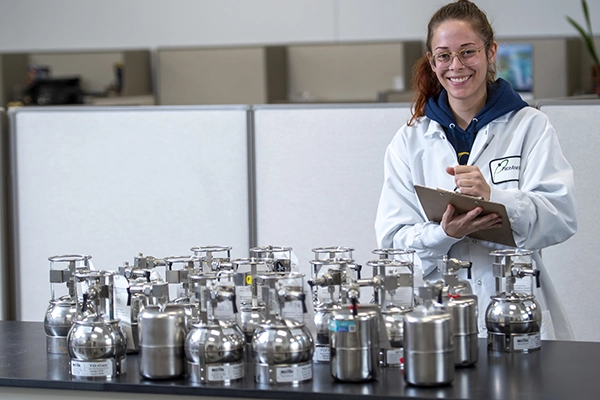Ambient Air Quality Monitoring
The United States Environment Protection Agency (EPA) defines ambient air monitoring as the systematic, long-term assessment of pollutant levels by measuring the quantity and types of certain pollutants in the surrounding, outdoor air. Monitoring of ambient air is an integral part of an effective air quality management system, with different methods used to measure any given pollutant.
Using state-of-the-art technology, the Pace® team collects, stores, handles and analyzes samples to meet the national ambient air quality standards. We will work with the customer and examine the options to determine which methods are most appropriate, considering the main uses of the data, initial investment costs for equipment, operating costs, reliability of systems, and ease of operation. Our team will use this information to develop a comprehensive monitoring strategy for the customer.
Let Pace® help you comply with the national ambient air quality standards.
OR
Ambient Air FAQs
Ambient air is all round us. Keeping it free of harmful contaminants is crucial to public health and the environment.

Ambient air refers to the natural state of atmospheric air, free from air-borne pollutants. Its composition typically consists of 78% nitrogen and 21% oxygen, with the remaining 1% made up of carbon, helium, methane, argon, and hydrogen. The percentage of oxygen in ambient air increases as the altitude decreases. Unfortunately, human activities such as manufacturing and the burning of fossil fuels have significantly decreased the quality of our ambient air by releasing large amounts of industrial and chemical pollutants into the atmosphere.
According to the World Health Organization (WHO), ambient air pollution refers to harmful pollutants that are released into the air by various sources such as households, industries, cars, and trucks. Among these pollutants, fine particulate matter has the most significant impact on human health. This type of matter mainly comes from the burning of fuels in power plants, vehicles, households, industries, and biomass. WHO estimates that fine particulate matter is responsible for causing 25% of lung cancer deaths, 8% of chronic obstructive pulmonary disease (COPD) deaths, and 15% of ischemic heart disease and stroke.
Under the Clean Air Act, EPA sets limits on certain air pollutants, including setting limits on how much can be in the air anywhere in the United States. The Clean Air Act also gives EPA the authority to limit emissions of air pollutants coming from sources like chemical plants, utilities, and steel mills. Individual states or tribes may have stronger air pollution laws, but they may not have weaker pollution limits than those set by EPA.
Established under the Clean Air Act, the NAAQS provides limits on the atmospheric concentration of six pollutants that cause smog, acid rain, and other public health hazards. The six criteria air pollutants (CAP), for which limits are set in the NAAQS are ozone (O3), atmospheric particulate matter, lead, carbon monoxide (CO), sulfur oxides (SOx), and nitrogen oxides (NOx).
These pollutants are emitted from many sources, including manufacturing, mining, transportation, electricity generation and agriculture. In many cases they are the products of the combustion of fossil fuels or industrial processes.
Test Method TO-15A: What You Need To Know
The EPA has promulgated a new ambient air testing method under the name TO-15A, but it is not the update to the current method TO-15 method that the name implies. Method TO-15A is specifically written for trace-level testing of ambient air in specially prepared summa canisters. The Pace® ambient air testing team has developed two resources to help customers understand TO-15A including how it’s different from TO-15, when to use it, and some of the challenges involved.
Your Ambient Air Monitoring Partner
Pace® offers a complete range of ambient air testing and monitoring designed to complement and support your needs by working with facility environmental and process engineers, consultants, and government regulatory agencies. With over three decades of experience, We innovative solutions to environmental challenges and routine methodologies to cost-effectively serve your monitoring needs.
- Full-Service Emission Testing Provider
- National Experience - Compliance testing in over (40) states
- Accredited to ASTM D7036-04, ISO/IEC 17025:2017, and TNI FSMO 2014
- Extensive Formalized Safety Program (ISNetworld, BROWZ, PEC Premier, SMI)
- Customer Service: Single Point of Contact and Dedicated Project Manager
Ambient Air Services
- Passive Monitoring
- Deposition Monitoring to Support the Fenceline
- Total Suspended Particulate (TSP) Matter
- Fine Particulate Matter (PM-10 & PM-2.5)
- Canister/Tedlar
- Continuous Monitoring
- High and Low Volume Sampling
- Sorbent Tube Active Sampling
Additional Resources
-
Pace® Environmental Certifications
-
Pace® Environmental Emergency Response
-
Related Pages
-
Downloadable Resources
Need to find a lab that can handle your unique requirements?
Contact us directly or download our list of environmental certifications across our network.
When disaster strikes, the Pace® Environmental Emergency Response Team is here to help you act fast.